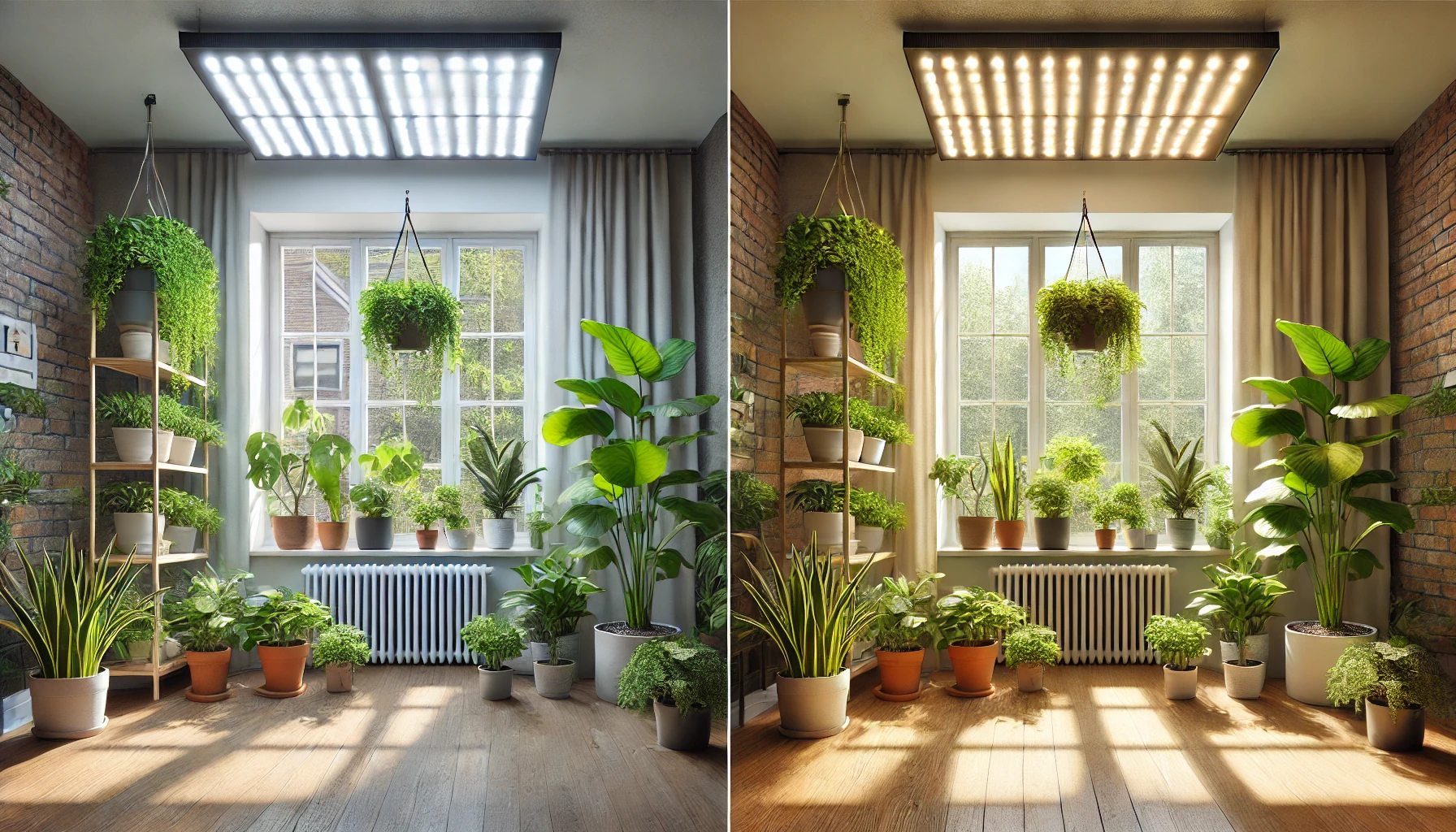One of the most important elements in plant care is light — without it, plants can’t perform photosynthesis, the process that fuels their growth. But when you’re growing plants indoors, natural sunlight isn’t always available in the amount or intensity that your plants need.
That’s where artificial light comes in. But is it as good as sunlight? Can you use both? And how do you know what’s best for your specific plants?
In this article, we’ll explore the differences between natural and artificial light, the pros and cons of each, and how to choose the right lighting setup for your indoor garden.
Why Light Matters for Houseplants
Light is energy. Through photosynthesis, plants use light to:
- Grow new leaves and roots
- Maintain their structure
- Produce oxygen
- Develop flowers and fruit (for certain species)
Without enough light, even the healthiest watering and fertilizing routines won’t save your plant. It may grow slowly, lose color, or stop growing altogether.
Understanding Light Terminology
Before diving into the comparison, it helps to understand a few common lighting terms:
- Direct Light: Sunlight that shines directly on the plant (e.g., next to a south-facing window)
- Indirect Light: Bright but filtered light, such as light passing through sheer curtains
- Low Light: Dim areas far from windows or with little sun exposure
- Photoperiod: The length of time a plant receives light daily
- Light Intensity: The strength of light the plant receives — higher intensity promotes more growth
Different plants have different light needs, so matching the light source to the plant type is essential.
Natural Light: The Gold Standard (When Available)
Natural sunlight is the most complete and balanced form of light for plants. It contains all the wavelengths they need to grow strong and healthy.
Pros of Natural Light:
- Full light spectrum (ideal for photosynthesis)
- It’s free!
- Helps plants grow naturally and vigorously
Cons of Natural Light:
- Inconsistent — varies with time of day, season, and weather
- May be too intense in summer or too weak in winter
- Not always available in all rooms or apartments
Best for:
- South or west-facing windows with direct or indirect light
- Plants that require bright light like succulents, fiddle leaf figs, or bird of paradise
Tips:
- Use sheer curtains to filter intense sun
- Rotate plants weekly to ensure even growth
- Use mirrors to reflect light into darker corners
Artificial Light: A Practical Substitute (and Companion)
Artificial lights can be an excellent solution for homes with low natural light or for plant lovers who want to grow in any room.
Types of artificial lights:
1. Fluorescent Lights
- Budget-friendly and widely available
- Good for herbs, ferns, and low-light tropicals
- Low heat emission
2. LED Grow Lights
- Energy-efficient and long-lasting
- Available in full spectrum or tailored spectrums
- Suitable for all plant types
3. Incandescent Lights
- Not ideal for plant growth
- Produce more heat than useful light
- Can damage plants if placed too close
4. Compact Fluorescent Lamps (CFLs)
- Good for small setups and single plants
- Fit standard light fixtures
- Better than regular bulbs for plant growth
Pros of Artificial Light:
- Can be placed anywhere, anytime
- Adjustable duration and intensity
- Enables year-round growing
- Great for seedlings, propagation, or plants in windowless rooms
Cons of Artificial Light:
- Requires initial investment in fixtures
- Needs to be used correctly (distance, duration, type)
- Lacks natural fluctuations that some plants benefit from
Best for:
- Low-light spaces
- Nighttime lighting supplementation
- Specific growth phases like seed starting
How to Combine Natural and Artificial Light
For many indoor gardeners, a mix of natural and artificial light offers the best results. You can place plants near a window and use grow lights during darker days, winter months, or evenings.
Smart lighting tips:
- Place LED lights 6–12 inches above plants
- Use a timer to simulate natural day/night cycles (12–16 hours of light per day is ideal for most plants)
- Group light-loving plants closer to the source
- Use reflective surfaces to maximize coverage
Combining both types of light ensures consistency — and healthier, more resilient plants.
How to Tell If Your Plant Needs More Light
Even if you think your plant is getting enough light, it may be signaling otherwise. Watch for these signs:
- Leggy or stretched stems
- Pale or faded leaves
- Slow or no new growth
- Leaves turning yellow or dropping
If you see these symptoms, increase light exposure gradually. Move the plant closer to a window or add a grow light.
Matching Light to Plant Type
Here’s a quick reference:
| Light Requirement | Example Plants | Ideal Source |
|---|---|---|
| Low Light | ZZ Plant, Snake Plant, Pothos | North-facing window or grow light |
| Medium Light | Peace Lily, Spider Plant, Calathea | East-facing window or CFLs |
| Bright Light | Succulents, Fiddle Leaf Fig, Aloe | South/west window or LED grow lights |
Know your plant’s preference and adapt accordingly.
Final Thoughts: Lighting Your Way to Healthier Plants
The battle between natural light vs. artificial light isn’t about picking one over the other — it’s about understanding what each offers and what your plants truly need.
If your space is filled with sunlight, take advantage of it. If it’s not, artificial lighting gives you the freedom to grow anywhere. And when used together, they create an ideal environment where your indoor jungle can truly flourish.
With the right lighting setup, your houseplants won’t just survive — they’ll thrive.
